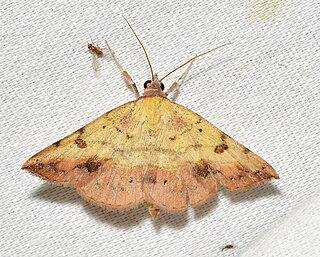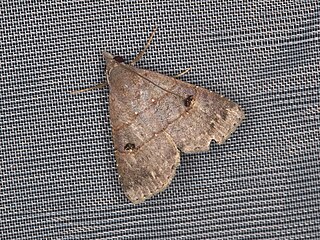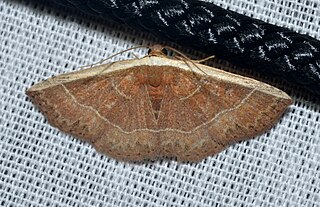Contents
| Mursa | |
|---|---|
| Scientific classification | |
| Domain: | Eukaryota |
| Kingdom: | Animalia |
| Phylum: | Arthropoda |
| Class: | Insecta |
| Order: | Lepidoptera |
| Superfamily: | Noctuoidea |
| Family: | Erebidae |
| Subfamily: | Boletobiinae |
| Genus: | Mursa Walker, 1859 |
| Synonyms | |
| |
| Mursa | |
|---|---|
| Scientific classification | |
| Domain: | Eukaryota |
| Kingdom: | Animalia |
| Phylum: | Arthropoda |
| Class: | Insecta |
| Order: | Lepidoptera |
| Superfamily: | Noctuoidea |
| Family: | Erebidae |
| Subfamily: | Boletobiinae |
| Genus: | Mursa Walker, 1859 |
| Synonyms | |
| |
The genus has previously been classified in the subfamily Phytometrinae within Erebidae or in the subfamily Herminiinae of the family Noctuidae. [1] [2]

Noctuoidea is the superfamily of noctuid or "owlet" moths, and has more than 70,000 described species, the largest number of any Lepidopteran superfamily. Its classification has not yet reached a satisfactory or stable state. Since the end of the 20th century, increasing availability of molecular phylogenetic data for this hugely successful radiation has led to several competing proposals for a taxonomic arrangement that correctly represents the relationships between the major lineages.

The Ophiusini are a tribe of moths in the family Erebidae.

The Herminiinae are a subfamily of moths in the family Erebidae. The members of the subfamily are called litter moths because the caterpillars of most members feed on dead leaves of plants, though others feed on living leaves, and/or the mushrooms of fungi as in the case of genus Idia.
Janseodes is a monotypic moth genus of the family Erebidae erected by Pierre Viette in 1967. Its only species, Janseodes melanospila, was first described by Achille Guenée in 1852. It is found in India, South Africa and the US state of Florida.

Isogona is a genus of moths of the family Erebidae. The genus was erected by Achille Guenée in 1852.
Euaontia is a genus of moths of the family Erebidae.
Glympis is a genus of moths of the family Erebidae. The genus was erected by Francis Walker in 1859.

Hemeroplanis is a genus of moths of the family Erebidae. The genus was erected by Jacob Hübner in 1818.
Homocerynea is a monotypic moth genus of the family Erebidae. Its only species, Homocerynea cleoriformis, was found in the US state of Arizona. Both the genus and species were erected by William Barnes and James Halliday McDunnough in 1913.

Hormoschista is a monotypic moth genus of the family Erebidae described by Heinrich Benno Möschler in 1890. Its single species, Hormoschista latipalpis, the double-lined brown moth, was first described by Francis Walker in 1858. It is found in eastern North America and the Caribbean.

Hyperstrotia is a genus of moths of the family Erebidae. The genus was erected by George Hampson in 1910.
Lephana is a genus of moths of the family Erebidae. The genus was previously classified in the subfamily Calpinae of the family Noctuidae.
Ommatochila is a genus of moths of the family Erebidae. The genus was erected by Arthur Gardiner Butler in 1894.

Oruza is a genus of moths of the family Erebidae erected by Francis Walker in 1862.
Parahypenodes is a monotypic moth genus of the family Erebidae. Its only species, Parahypenodes quadralis, the masked parahypenodes moth, is found in the Canadian province of Quebec. Both the genus and species were first described by William Barnes and James Halliday McDunnough in 1918.

Phytometra is a genus of moths of the family Erebidae. The genus was described by Adrian Hardy Haworth in 1809.

The Anobinae are a subfamily of moths in the family Erebidae described by Jeremy Daniel Holloway in 2005. Common morphological characteristics of Anobine moths include a dark head and prothoracic collar, lighter color on the thorax, and either bipectinate antennae or antennae with flagellomeral setae in males.

The Boletobiinae are a subfamily of moths in the family Erebidae, containing about 956 species. The taxon was described by Achille Guenée in 1858.

The Hypenodinae are a subfamily of moths in the family Erebidae. Adult moths of most species of this subfamily lack small, simple eyes near the large, compound eyes and have quadrifine (four-veined) hindwing cells. The micronoctuid moths are an exception because they possess simple eyes and bifine (two-veined) hindwing cells.

The Rivulinae are a subfamily of moths in the family Erebidae described by Augustus Radcliffe Grote in 1895. Caterpillars in the subfamily typically have long, barbed hairs and have full prolegs on abdominal segments 3 through 6. The adults have a unique microsculpturing proboscis.